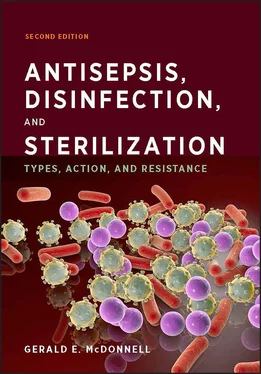The effects of various types of physical and chemical variables can be tested by using suspension methods. Physical effects include the product temperature and pH, while chemical effects include the biocide concentration or dilution, formulation type, and interfering substances, such as organic (e.g., serum and blood) and inorganic (e.g., heavy metals and hard water) soils. These effects are often important considerations in the practical use of the biocidal product.
Examples of some standardized suspension tests are given in Table 1.18.
Surface tests are used to verify the antimicrobial activity of a product or process on a test surface. This is an important consideration in the use of many surface antiseptics, disinfectants, and sterilants. Tests can be considered to belong to three types: carrier tests, simulated-use testing, and in-use testing.
In carrier methods, the test microorganism is inoculated onto a defined carrier material, in the presence or absence of interfering soils, and is then exposed to the biocidal process or product. The carrier material can simply consist of a coupon (a piece) of any test surface (including paper, stainless steel, glass, or plastic) or a defined test carrier; for example, stainless steel and porcelain penicylinders are widely used in the United States to test the surface-disinfectant efficacies of products. For antiseptic testing, sections of ex vivo skin have been used as test surfaces. Following exposure, the test coupons are retrieved (with neutralization if required) and tested for the survival of the test microorganism. This can also be performed qualitatively (by immersion into growth medium and incubation, followed by observation of growth or no growth) or quantitatively (by elution of the test culture and direct enumeration or fraction-negative determination, as described in section 1.4.2.1). Examples of various types of standardized carrier tests are given in Table 1.19. Some of the most widely used carrier tests are defined biological and chemical indicators used for various sterilization process tests, which are described in more detail in section 1.4.2.3.
TABLE 1.18 Examples of standardized suspension tests
| Reference a |
Title |
Summary |
| AOAC Official Method 955.11 |
Testing Disinfectants against Salmonella typhi (includes phenol coefficient method) |
Tests the bactericidal activity in comparison to known concentrations of phenol (also used to standardize test cultures) using Salmonella typhi, Staphylococcus aureus , and Pseudomonas aeruginosa |
| ASTM E1052-96 (2002) |
Standard Test Method for Efficacy of Antimicrobial Agents Against Viruses in Suspension |
Guidelines on testing of the virucidal activity of a product in suspension |
| ASTM E1891-97 (2002) |
Standard Guide for Determination of a Survival Curve for Antimicrobial Agents Against Selected Microorganisms and Calculation of a D-Value and Concentration Coefficient |
Guidelines on the determination of survival curves and calculation of D values |
| USP XXIII |
Antimicrobial Preservatives—Effectiveness Protocol |
Guidelines to confirm the preservative effectiveness in a formulated product by inoculation of Staphylococcus aureus, Escherichia coli, Pseudomonas aeruginosa, Candida albicans , and Aspergillus niger ; determines that a product does not promote but prevents microbial growth over time |
| EN 1040:1997 |
Chemical Disinfectants and Antiseptics. Basic Bactericidal Activity. Test Method and Requirements (Phase 1) |
Testing for the basic bactericidal efficacy of a disinfectant or antiseptic using Pseudomonas aeruginosa and Staphylococcus aureus ; required to observe ≥10 5-log-unit reduction in 60 s |
| EN 1650:1997 |
Chemical Disinfectants and Antiseptics. Quantitative Suspension Test for Evaluation of Fungicidal Activity of Chemical Disinfectants and Antiseptics Used in Food, Industrial, Domestic and Institutional Areas. Test Method and Requirements, (Phase 2, Step 1) |
Testing for fungicidal activity of a disinfectant or antiseptic using Candida albicans and Aspergillus niger in the presence of hard water (if dilution is required) and organic soil (albumin, skim milk, and other components); required to observe ≥10 4-logunit reduction in 15 min |
| EN 13610:2002 |
Chemical Disinfectants. Quantitative Suspension Test for the Evaluation of Virucidal Activity against Bacteriophages of Chemical Disinfectants Used in Food and Industrial Areas. Test Method and Requirements (Phase 2, Step 1) |
Testing for virucidal activity using Lactococcus lactis F7/2 bacteriophage; required to show ≥10 4-log-unit reduction in 15 min |
a AOAC, Association of Official Analytical Chemists; ASTM, American Society for Testing and Materials; USP, U. S. Pharmacopeia; EN, European Norm, from the CEN (European Committee for Standardization).
Simulated-use tests are also laboratory based; an artificial inoculum is applied to a surface to simulate the actual use of the product or process in a typical application. Examples are the use of an artificial inoculum on the skin or on various surfaces, such as medical devices. In these methods, it is important to validate the test methods, including the inoculation method and neutralization and recovery methods, to ensure that they are reproducible and reliable. As well as direct application of the test culture to a surface, in some situations, the microbial culture can be inoculated onto a carrier or inserted into the test equipment at a worst-case location (e.g., in the internal channel of a lumened device), exposed to the product or process, and recovered for evaluation. Recovery methods can include elution, swabbing, air filtering, and use of contact plates. Examples of various simulated-use test guidelines and standards are given in Table 1.20.
TABLE 1.19 Examples of standardized carrier tests
| Reference a |
Title |
Summary |
| AOAC Official Methods 991.47, 991.48, 991.49 |
Hard Surface Carrier Test |
Bactericidal activities of disinfectant/sterilants against Pseudomonas aeruginosa, Staphylococcus aureus , and Salmonella enterica serovar Choleraesuis quantitatively inoculated onto glass penicylinders; carriers tested for growth/no growth following exposure |
| AOAC Official Method |
Tuberculocidal Activity of Disinfectants |
Porcelain penicylinders contaminated with Mycobacterium bovis and exposed to the product; carriers tested for growth/no growth following exposure |
| AOAC Official Method 966.04 |
Sporicidal Test Method |
Clostridium sporogenes and Bacillus subtilis cultures (including spores) dried onto porcelain penicylinders and suture loop carriers; exposed to the test disinfectant/sterilant for the required time and incubated to detect the presence/absence of growth; includes an HCl resistance test to confirm the acid resistance of the spores |
| ASTM E1053 |
Standard Test Method for Efficacy of Virucidal Agents Intended for Inanimate Environmental Surfaces |
Guidelines on testing of the virucidal activity of a product on an inanimate surface |
| ASTM E2111 |
Standard Quantitative Carrier Test Method To Evaluate the Bactericidal, Fungicidal, Mycobactericidal and Sporicidal Potencies of Liquid Chemical Germicides |
Carrier (glass vials) test for the potencies of liquid disinfectants against bacteria and fungi |
| EN 13697 |
Chemical Disinfectants and Antiseptics. Quantitative Non-Porous Surface Test for the Evaluation of Bactericidal and/or Fungicidal Activity of Chemical Disinfectants Used in Food, Industrial, Domestic and Institutional Areas. Test Method and Requirements |
Various bacteria (e.g., Pseudomonas aeruginosa and Enterococcus hirae ) and fungi ( Candida albicans and Aspergillus niger ) inoculated onto stainless steel discs in the presence/absence of interfering soil and exposed to the test disinfectant/antiseptic; must demonstrate a ≥10 4reduction of bacteria in 5 min and ≥10 3reduction of fungi in 15 min |
a AOAC, Association of Official Analytical Chemists; ASTM, American Society for Testing and Materials; EN, European Norm, from the CEN (European Committee for Standardization).
Читать дальше












